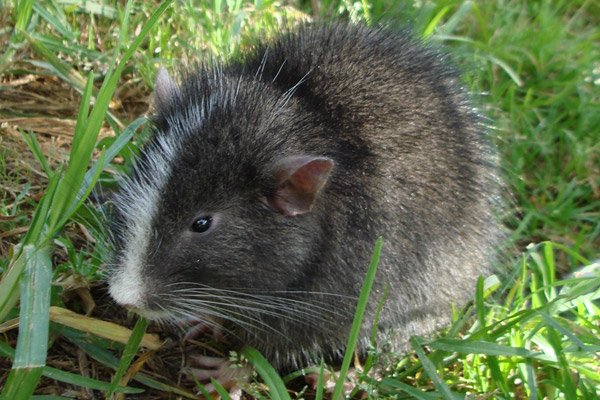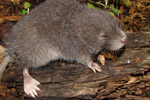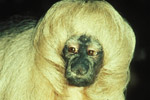Rediscovered mammal had been slaughtered by the Inca hundreds of years ago

The Machu Picchu arboreal chinchilla rat come back to life! Photo by: Roberto Quispe.
Below one of the most famous archaeological sites in the world, scientists have made a remarkable discovery: a living cat-sized mammal that, until now, was only known from bones.
The Machu Picchu arboreal chinchilla rat (Cuscomys oblativa) was first described from two enigmatic skulls discovered in Inca pottery sculpted 400 years ago. Dug up by Hiram Bingham in 1912, the skulls were believed to belong to a species that went extinct even before Francisco Pizarro showed up in Peru with his motley army. Yet, all that changed in 2009 when a park ranger, Roberto Quispe, found what was believed to be a living Machu Picchu arboreal chinchilla rat near the original archaeological site.
“In Conservation Biology this type of rediscoveries is called the Lazarus effect,” writes a team of Mexican and Peruvian scientists in a press release, who years later sought to confirm Quispe’s discovery.
 Note the large size of the Machu Picchu arboreal chinchilla rat. Photo by: Roberto Quispe. |
The scientists—headed up by Horacio Zeballos the curator of the Department of Mammalogy at the Museum de Arequipa and Gerardo Ceballos from the Instituto de Ecología of the Universidad Nacional Autónoma de México—headed into the field in 2012 and tracked down the elusive mammal in the cloud forests near Wiñayhuayna, another archaeological site on the Inca Trail heading towards Machu Picchu.
“Hard field work was conducted with the spectacular archaeological site as part of the landscape, on very steep hills, with slopes of up to 60 degrees of inclination, dominated by montane forests, with leafy trees covered with mosses, lichens and other plants,” the scientists write.
In the end, they were able to find a living specimen, confirming that the Machu Picchu arboreal chinchilla rat actually never went extinct.
However, Ceballos told mongabay.com that he believes the species is likely endangered “because [of] its rarity and habitat destruction.”
He adds that, “large tracts of native forests have been destroyed because of agriculture and cattle grazing…in its extremely limited
geographic range.”
On the plus side, the species is found in both Machu Picchu National Park and the Historic Sanctuary of Machu Picchu.
“Both the National Park and the Historic Sanctuary are relatively well-managed. They have staff and some infrastructure,” Ceballos said, adding that “it seems that the Federal Government has become more interested in reducing deforestation in the National Park and the Sanctuary in recent years.”
But the Machu Picchu arboreal chinchilla rat wasn’t the only discovery the team made. In addition, the team believe they have uncovered at least six species new to science, including a new mammal, a new lizard, and four new frogs in the same area.
“I am optimistic that the discovery of the [Machu Picchu arboreal chinchilla rat] and other new species will help to strengthen the
protection of the native forests,” Ceballos said.

The Machu Picchu arboreal chinchilla rat come back to life! Photo by: Roberto Quispe.
Related articles
Scientists uncover six potentially new species in Peru, including bizarre aquatic mammal (photos)

(09/25/2014) A group of Peruvian and Mexican scientists say they have uncovered at least six new species near South America’s most famous archaeological site: Machu Picchu. The discoveries include a new mammal, a new lizard, and four new frogs. While the scientists are working on formally describing the species, they have released photos and a few tantalizing details about the new discoveries.
Turning point for Peru’s forests? Norway and Germany put muscle and money behind ambitious agreement

(09/24/2014) From the Andes to the Amazon, Peru houses some of the world’s most spectacular forests. Proud and culturally-diverse indigenous tribes inhabit the interiors of the Peruvian Amazon, including some that have chosen little contact with the outside world. And even as scientists have identified tens-of-thousands of species that make their homes from the leaf litter to the canopy.
Conservationists use social media to take on Peru’s booming illegal wildlife trade

(09/04/2014) Illegal wildlife trafficking is thriving in Peru. But a Peruvian organization is now using a public campaign, via social media and press releases, to track and rescue illegally kept wildlife in the country. ‘I have filed 47 complaints from 14 different states in Peru including hundreds of animals commercialized illegally in markets, kept as pets, and used as tourist attractions,’ said Noga Shanee, Co-founder and project director of Neotropical Primate Conservation.
Scientists uncover five new species of ‘toupee’ monkeys in the Amazon

(09/02/2014) While saki monkeys may be characterized by floppy mops of hair that resemble the worst of human toupees, these acrobatic, tree-dwelling primates are essential for dispersing seeds. After long being neglected by both scientists and conservationists, a massive research effort by one intrepid researcher has revealed the full-scale of saki monkey diversity, uncovering five new species.
How do we save the world’s vanishing old-growth forests?

(08/26/2014) There’s nothing in the world like a primary forest, which has never been industrially logged or cleared by humans. They are often described as cathedral-like, due to pillar-like trees and carpet-like undergrowth. Yet, the world’s primary forests—also known as old-growth forests—are falling every year, and policy-makers are not doing enough to stop it.
A paradise being lost: Peru’s most important forests felled for timber, crops, roads, mining

(08/12/2014) In 1988, when British environmentalist Norman Myers first described the concept of a “biodiversity hotspot,” he could have been painting a picture of the highly threatened Peruvian Andes mountain range. Today, the Andes are an immediate and looming portent of the fate of the Peruvian Amazon rainforest.
Stunning high-resolution map reveals secrets of Peru’s forests

(07/30/2014) Peru’s landmass has just been mapped like never before, revealing important insights about the country’s forests that could help it unlock the value healthy and productive ecosystems afford humanity.